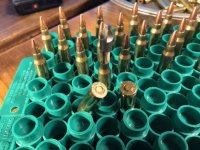Noticed on some of the loads that the primer, while well seated, seemed to be a touch flattened out.
Are we talking about live primers you have seated, or fired ones in the cases?
"flattened out" might, or might not have some meaning. Because there is "flattened" and then there is "FLATTENED!"
I've been "reading" primers for over half a century, and its not like reading tea leaves, nor is it pure bunk. Some of what people think they get from reading primers is bunk, some, isn't.
How, and how much the primer is flattened does tell you something. It doesn't tell you the exact pressure, or if it is in safe limits or not. I just tells you the pressure is abnormal for the system and components used.
WHY the pressure is different can't be told from the primers, only that it is different than what we expect to see.
Primers can be slightly flattened, which might be normal. They can be "flattened" to the point where the primer cup metal "flows" all the way to the edge of the primer pocket. This is not normal, and indicates higher then desired pressure. But it doesn't tell you how high the pressure was.
I've seen primers where the firing pin strike was almost flattened back out smooth. THis is way too much pressure, but again, no idea what the actual amount (number value in psi) is.
Primers can also be slightly "flattened" when seated, sometimes, and, if this is not noticed until after firing, can lead to false conclusions.
IF the fired primer doesn't look like you expect it to look, it tells you something unexpected is going on. What, and how much, and whether or not its a risk is up to you to figure out.
Good Luck!

